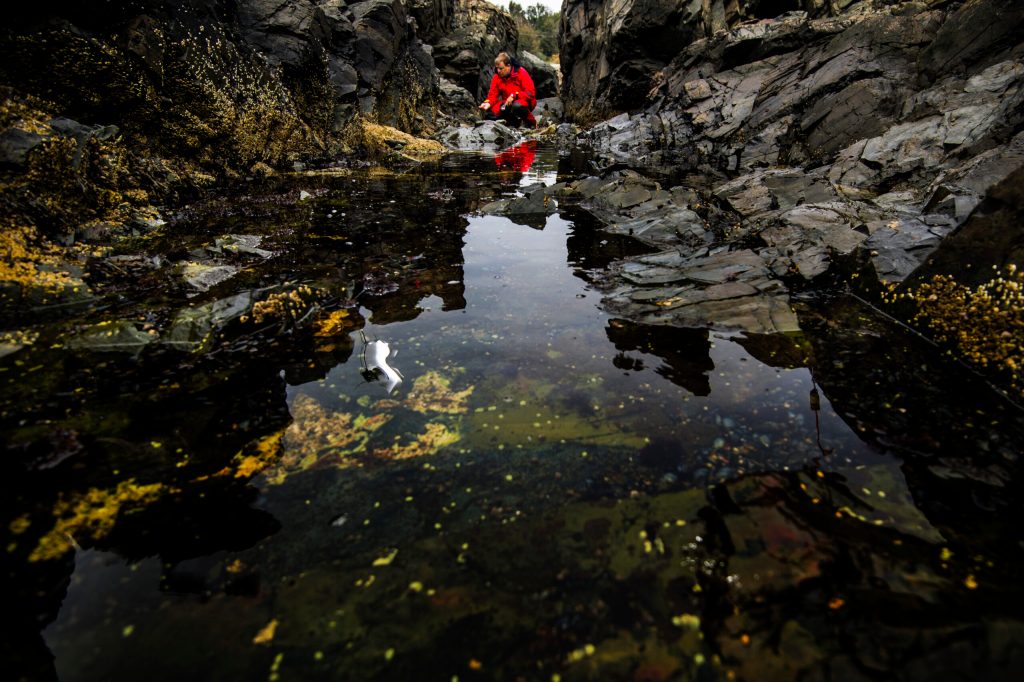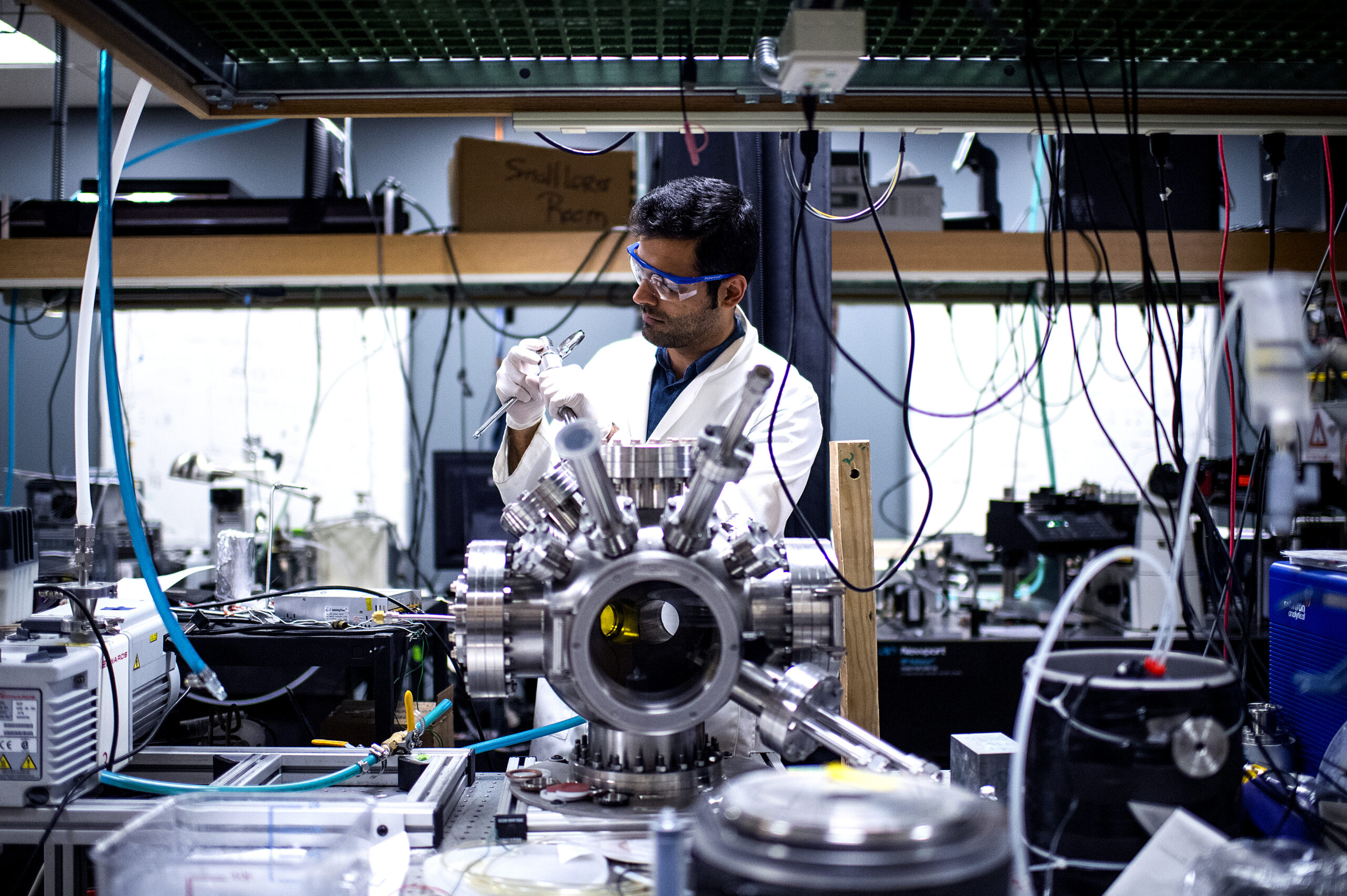Title
Topic
-
Therese Pirozzi receives grant for ‘Active Brain, Healthy Brain Exercise Program’
“Therese Pirozzi, associate professor in Bouvé College’s Department of Communication Sciences and Disorders, is a practicing speech-language pathologist with a focus on language and health literacy of low-income families, neuroplasticity of the brain, and the effects of brain injury on survivors and their families. Over the summer, she received a grant for the ‘Active Brain, Healthy Brain Exercise Program’ from the Community Endowment of Lexington—an endowed fund of the Foundation for MetroWest.”
-
‘Scaling Laws for Two-Dimensional Dendritic Crystal Growth in a Narrow Channel’
“We investigate analytically and computationally the dynamics of 2D needle crystal growth from the melt in a narrow channel. Our analytical theory predicts that, in the low supersaturation limit, the growth velocity V decreases in time t as a power law V∼t−2/3, which we validate by phase-field and dendritic-needle-network simulations.” See the full list of authors and read this pre-print at ArXiv.
-
Functional insights into protein signaling
This review in the journal Life provides “Functional Insights into Protein Kinase A (PKA) Signaling from C. elegans.” PhD. students Fereshteh Sadeghian and Perla Castaneda, along with postdoctoral researcher Mustafi Amin and professor of biology Erin Cram, write that Caenorhabditis elegans, an unsegmented nematode, “provides a powerful genetic platform for understanding how [PKA] can regulate an astounding variety of physiological responses.”
-
Better diagnoses for visual vergence disorders
Common vergence disorders, characterized by instability between a subject’s eyes as they try to focus on an object (convergence and divergence), can be diagnosed by examining the horizontal fusional reserves of the eye. This study looks at “Infrared eyetracking technology [which] shows promise for obtaining automated and objective measurements of fusional reserves.” This paper is the result of an international collaboration with the University of Auckland, New Zealand. See the full list of authors and read their research, “Objective estimation of fusional reserves using infrared eye tracking: the digital fusion-range test,” in Clinical and Experimental Optometry.
-
Record performance on display for named data networking delivery platform
Electrical and computer engineering professor Edmund Yeh, leading a multi-university project on named data networking for data-intensive science experiments (N-DISE), has “demonstrated a record average throughput of 50 Gbps and peak throughput of 63 Gbps for the N-DISE data delivery platform on a transcontinental wide area network testbed.” The project involves collaborators from Northeastern University, the California Institute of Technology, the University of California Los Angeles, and the Tennessee Technological University. Read more about their demonstrations at the College of Engineering.
-
Coastal upwelling helps delicate species survive
This article is an important addition to our understanding of species abundance and distribution—a subject becoming ever more important with ongoing climate change. For this study, researchers used “wavelet analysis” to examine sixteen intertidal zones along the the coast of Europe. Results show that “upwelling”—a process that brings deep, cold water to the surface—produces refuges for thermally delicate species by mitigating rising temperatures. See the full list of authors and read “Coastal upwelling generates cryptic temperature refugia” in Nature.
-
Yongmin Liu elected 2023 Fellow Member of Optica for research in nanophotonics
“Associate Professor Yongmin Liu was elected as a 2023 Fellow Member of Optica. Fellow membership in Optica is limited to no more than ten percent of the membership and is reserved for members who have served with distinction in the advancement of optics and photonics. Liu is being honored specifically for significant contributions to the fundamental and application of nanophotonics, particularly plasmonics and photonic metamaterials.”
-
Northeastern researchers win ‘Invented Here!’ contest
“This year, the Center for Research Innovation is excited to share that multiple Northeastern researchers have been honored in the annual Invented Here! contest, held by the Boston Patent Law Association (BPLA). Established in 2010 by the BPLA, the Invented Here! contest is meant to celebrate local New England inventors, from their inventions to their own stories. Over 49 inventions and over 170 inventors have been recognized since 2010. These inventors are key to furthering innovation not only in our region, but across the world.”
-
Student-centered climate work at the Marine Science Center
Professor of environmental sciences Kristina Faul came from Mills College at Northeastern to visit the Marine Science Center. She delivered a talk on student-centered climate change work in November 2022.
-
‘Effect of Dissolved Humic Acids and Coated Humic Acids on Tetracycline Adsorption by K₂CO₃-Activated Magnetic Biochar’
“Humic acids (HAs) widely exist in water environment, and has an important impact on the adsorption of pollutants. Herein, HAs (both dissolved and coated) was employed to assess the effect on the removal of the organic contaminant tetracycline (TC) by K2CO3 modified magnetic biochar (KMBC). Results showed that low concentration of dissolved HAs promoted TC removal, likely due to a bridging effect, while higher concentration of dissolved HAs inhibited TC adsorption because of the competition of adsorption sites on KMBC.” Find the paper and the full list of authors in Scientific Reports.
-
Nusbaum receives 2022 AESA Critics’ Choice Book Award
Emily Nusbaum and Jessica Nina Lester (Indiana University) have won the American Educational Studies Association 2022 award for their recent co-edited book, “Centering Diverse Bodyminds in Critical Qualitative Inquiry.” The editors approach “disability embodiment and the lived experience of disability [as] potential sources of method and methodological advancement.”
-
What is ‘Wasta,’ and how does it affect business in the Arab world?
“Recent research examines business practices in the Arab world and how they differ from Western practices. Wasta is a practice in Arab society where people use their personal relationships to gain favor… Foreign firm managers operating in Arab societies will need to develop a solid understanding of the practice and its different perceptions among varying Arab groups in order to be successful in conducting business in the Arab world.” Find the paper and the full list of authors at the Insights @ Center for Emerging Markets.
-
Bribery and the ‘new normal’ in transition economies
“Recent research examines 310 privately owned small and medium-sized companies from 22 transition economies in Eastern Europe and Former Soviet Republics to see how the payment of bribes affects entrepreneur perceptions of the business environment. Those who more frequently pay bribes create a “new normal” business environment that is perceived as increasingly harsh. However, for entrepreneurs who infrequently bribe, their ‘new normal’ is likely to be perceived as more supportive of business.” Read “How Bribe-Payers Create a ‘New Normal’ of Corruption in Transition Economies” and see the full list of authors at the Insights @ Center for Emerging Markets.
-
Will eating (certain) plants increase cognitive health in children? This study hopes to find out
With “Enhancing children’s cognitive function and achievement through carotenoid consumption: The Integrated Childhood Ocular Nutrition Study (iCONS) protocol,” researchers hope to discover the effect of carotenoids (plant pigments) on preadolescence. Carotenoids have been shown to positively impact cognition in adults, and this proposed, placebo-controlled, double-blind study will by the first to study the effect of two of these pigments—lutein and zeaxanthin—on preadolescents. Their hypothesis states, “children receiving the carotenoid supplement will exhibit greater gains in cognitive function and achievement relative to the waitlist placebo group.” Find the full list of authors and their research in Contemporary Clinical Trials.
-
Understanding the photochemistry of solar panel systems
Norbornadiene is a hydrocarbon useful in storing solar energy due to its “high energy storage density,” but much of the mechanism by which it functions is not understood. In “Multiconfigurational Calculations and Photodynamics Describe Norbornadiene Photochemistry,” the authors “present a full computational study on the excited-state deactivation mechanism of [norbornadiene] in the gas phase.” Find the paper and the full list of authors at ChemRxiv.
-
Breakthrough in potential treatments for opioid use disorders
This paper investigates the “CB1 receptors,” and identified an antagonist to that receptor, AM4113, which “effectively blocked fentanyl discrimination” in male rats. The results of the study show that “targeting CB1 receptors might be a viable approach to develop new medications for opioid use disorders.” Read “Effects of the cannabinoid CB1-receptor neutral antagonist AM4113 and antagonist/inverse agonist rimonabant on fentanyl discrimination in male rats” and find the full list of authors in Drug and Alcohol Dependence.
-
Audit disclosures remain ‘highly relevant’ to investors
In this article on the impact that audit disclosures have on investors and their judgments, the authors take “a ‘what if’ exploratory public policy perspective of evaluating the potential effects on investors’ audit quality judgments and investment decisions.” They use two experiments to “manipulate: inspection reporting… and inspection selection method,” ultimately finding “that disclosure of audit strengths is highly relevant to investment decisions.” Read “An Examination of the Effects of PCAOB Inspection Selection Method and Disclosure of Audit Strengths on Investor Judgments” and see the full list of authors in Auditing: A Journal of Practice and Theory.
-
Memory and culture at Queens College Colloquium
Associate Dean Christie Chung gave a talk at Queens College, New York, on October 31, 2022, entitled, “A Cross-Cultural Examination of the Age-related Positivity Effect in Memory.” The talk was based on her research, published in the International Journal of Aging and Human Development.
-
How young people think about AI, and how to help them understand it
Youth often claim that they don’t “trust” artificial intelligence, but the authors of this research studied actual youth understanding of how AI works, and instantiated a program that “deepened their understanding of AI” and “empowered them to creatively express their understandings and apprehensions about AI.” Participants in the study were primarily BIPOC and from underprivileged backgrounds, with lessened access to STEM fields. See the full list of authors and read their research paper, “In the Black Mirror: Youth Investigations into Artificial Intelligence,” in ACM Transactions on Computing Education.
-
‘De Novo Asymmetric Achmatowicz Approach to Oligosaccharide Natural Products’
“The development and application of the asymmetric synthesis of oligosaccharides from achiral starting materials is reviewed. This de novo asymmetric approach centers around the use of asymmetric catalysis for the synthesis of optically pure furan alcohols in conjunction with Achmatowicz oxidative rearrangement for the synthesis of various pyranones.” Find the paper and the full list of authors at Chemical Communications.
-
Measuring how early-life trauma affects anxiety
This studies deepens our understanding of the connection between “Early life adversity” and “the incidence of later-life anxiety disorders.” By measuring the ultrasonic vocalizations of rats separated from their mothers at early stages, they identify the effects this separation can have later in life. The paper also measures the differing responses between male and female rats. Read “Age- and sex-specific effects of maternal separation on the acoustic startle reflex in rats: early baseline enhancement in females and blunted response to ambiguous threat” and find the full list of authors in Frontiers in Behavioral Neuroscience.
-
Collecting the microbiomes of ‘blue carbon’ ecosystems

So-called “blue carbon” ecosystems are marine environments that serve as valuable carbon sinks, and are thus vital aids against climate change. Their effectivity, however, “is strongly influenced by the metabolism of soil-associated microbes.” As genetic sequencing technologies continue to improve, scientists can collect “tremendous amounts of data on what taxa comprise belowground microbial assemblages.” This paper provides a “toolbox… for the acquisition, management, and integration of Blue Carbon-associated sequencing data and metadata to potentially elucidate novel mechanisms behind Blue Carbon dynamics.” Read “Pathways for Understanding Blue Carbon Microbiomes with Amplicon Sequencing,” and see the full list of authors in Microorganisms.
